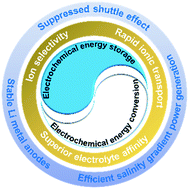Advanced metal–organic framework-based membranes with ion selectivity for boosting electrochemical energy storage and conversion
Abstract
The selective transport of charge carriers has a great impact on the efficiency of electrochemical energy storage and conversion. However, pursuing membranes with high-performance ion selectivity is one of the most crucial issues for their further progress. In recent years, based on their superior intrinsically physical and chemical properties including abundant nano-sized channels, open metal sites and electrostatic interaction, metal–organic frameworks (MOFs) have shown enormous potential for the construction of membranes with ion selectivity. In this review, the design and mechanism of MOF-based membranes with ion selectivity are first discussed. Based on this, the applications of these membranes in typical electrochemical energy storage and conversion systems are summarized. Based on the recent advances, the existing challenges and the future perspectives are discussed. This review will offer new insights for understanding the ion transport in MOF-based membranes with ion selectivity towards high-performance electrochemical energy storage and conversion.

- This article is part of the themed collection: Journal of Materials Chemistry A Recent Review Articles


 Please wait while we load your content...
Please wait while we load your content...